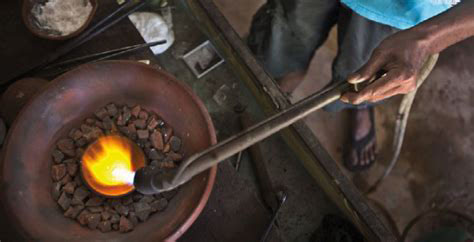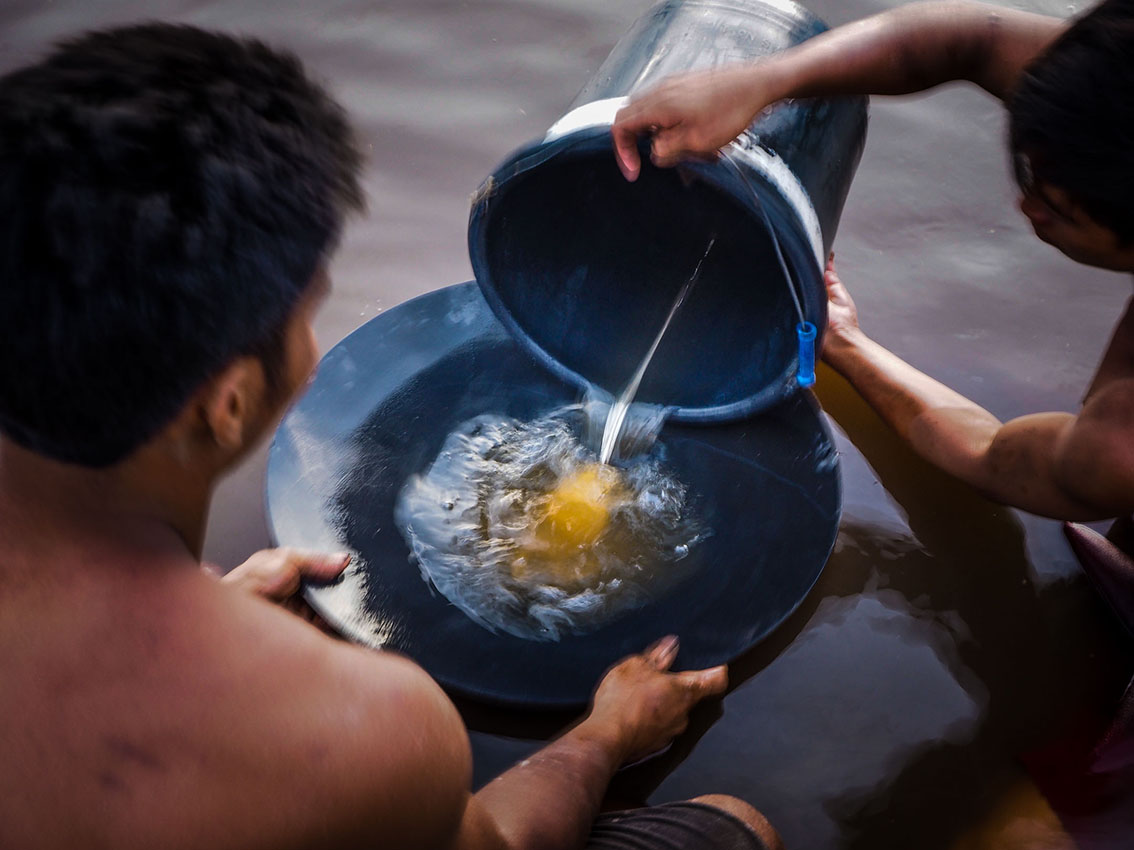Dr. Louisa J. Esdaile
Dr. Justin M. Chalker
First published: 03 January 2018
Mercury-dependent artisanal and small-scale gold mining (ASGM) is the largest source of mercury pollution on Earth. In this practice, elemental mercury is used to extract gold from ore as an amalgam. The amalgam is typically isolated by hand and then heated—often with a torch or over a stove—to distill the mercury and isolate the gold. Mercury release from tailings and vaporized mercury exceed 1000 tonnes each year from ASGM. The health effects on the miners are dire, with inhaled mercury leading to neurological damage and other health issues. The communities near these mines are also affected due to mercury contamination of water and soil and subsequent accumulation in food staples, such as fish—a major source of dietary protein in many ASGM regions. The risks to children are also substantial, with mercury emissions from ASGM resulting in both physical and mental disabilities and compromised development. Between 10 and 19 million people use mercury to mine for gold in more than 70 countries, making mercury pollution from ASGM a global issue. With the Minamata Convention on Mercury entering force this year, there is political motivation to help overcome the problem of mercury in ASGM. In this effort, chemists can play a central role. Here, the problem of mercury in ASGM is reviewed with a discussion on how the chemistry community can contribute solutions. Introducing portable and low-cost mercury sensors, inexpensive and scalable remediation technologies, novel methods to prevent mercury uptake in fish and food crops, and efficient and easy-to-use mercury-free mining techniques are all ways in which the chemistry community can help. To meet these challenges, it is critical that new technologies or techniques are low-cost and adaptable to the remote and under‐resourced areas in which ASGM is most common. The problem of mercury pollution in ASGM is inherently a chemistry problem. We therefore encourage the chemistry community to consider and address this issue that affects the health of millions of people.

The Mercury Problem in Artisanal Gold Mining
Mercury-based artisanal and small-scale gold mining (ASGM) causes more mercury pollution than any other human activity. In this practice, mercury metal is used to extract gold from ore as a stable amalgam. The amalgam is then heated to evaporate the mercury and isolate the gold. While mercury amalgamation has been used for thousands of years to mine gold and silver, it is unfortunately still a widespread technique in present-day artisanal gold mining. Mercury is abundant and inexpensive, sourced through a variety of industrial supply chains or mined directly from cinnabar, making it a readily available tool for mining gold. It is estimated that between 410 and 1400 tonnes of mercury are emitted through ASGM each year, accounting for 37 % of global mercury emissions. Driven by rising prices in gold (approximately $40,000 USD kg−1 for most of 2017) ASGM is widespread, with an estimated 10 to 19 million miners working primarily in Asia, Africa and South America. As many as 5 million women and children are involved directly in these mining operations. These miners typically live in impoverished areas and use gold mining as a source of income. In many cases, few other opportunities for employment exist in these regions and ASGM is therefore a critical way to sustain their livelihood.
These mining activities largely take place in the so‐called “informal” economy in which participants operate unlicensed or without legal authorization—a reason why effective regulation of mercury emissions is extraordinarily difficult. Nevertheless, these artisanal miners contribute substantially to the local and global economy, generating approximately 15 to 25 % of the world’s gold. So, while each individual mining operation may be relatively small, the practice is widespread. Because of the extraordinary amounts of mercury handled directly by the miners and released into the environment, the burden to human health is staggering. Mercury vapor inhaled by miners results in impaired cognitive function, neurological damage, kidney damage and several other health problems. In some cases, amalgams are processed near the home or in gold shops in villages or cities, so the mercury vapor generated in the process affects non-miners living in these areas. For children and fetuses, exposure to mercury pollution is especially dangerous as it increases the likelihood of physical deformities and neurological damage. These risks of mercury exposure are also compounded by the high levels of mercury that accumulate in fish and other food supplies in ASGM communities.
The mercury problem in ASGM is a growing crisis in environmental and human well-being. Rightfully, the issue has garnered attention in both the scientific and general news media as ASGM becomes more prevalent and its effects more visible. The damage to cognitive and neurological function of the miners and the physical and mental disabilities prevalent in children near ASGM communities are startlingly clear in these reports. Furthermore, the wider damage to the environment and the transport of high levels of mercury to sites beyond the mine have, in some cases, led to national conflict and military intervention. The time to address this problem is now.
On August 16th 2017, the Minamata Convention on Mercury was ratified by more than 50 parties to the treaty. This milestone brought into force the most comprehensive effort to control the trade, use and emissions of mercury. As ASGM is the largest source of mercury pollution worldwide, reforming this sector is a priority of the Minamata Convention. Accordingly, Article 7 of the convention requires signatories to “take steps to reduce, and where feasible eliminate, the use of mercury…and the emissions and releases to the environment of mercury from, such mining and processing.” There are also specific provisions for member nations to help educate miners and promote research into sustainable, mercury-free mining. In the accompanying Annex C of the Minamata Convention, further actions are prescribed that include the elimination of four especially problematic activities: whole-ore amalgamation, open heating of amalgams, heating amalgams in residential areas, and the use of cyanide to extract gold from mercury-rich tailings. Because these goals will likely require advances in environmental chemistry and innovative extractive technologies, it is worthwhile to consider how the chemistry community might contribute to these global initiatives. Finally, the urgency to address these challenges cannot be overstated as the parties to the convention have three years to develop and implement a national plan of action.
The purpose of this Mini review is to outline the process and consequences of mining gold by amalgamation with mercury. Then, we discuss some opportunities for the chemistry community to help solve the mercury problem in ASGM. For instance, there is a need for inexpensive and portable mercury sensors; low-cost and scalable remediation technology for air, water and soil; mining techniques that minimize mercury exposure and emissions; and reliable and easy-to-adopt methods for mercury-free mining. The majority of ASGM is carried out in developing nations by miners that rely on gold sales for their livelihood. Therefore, any technology designed to solve the mercury problem must be inexpensive and, ideally, support the miners in their trade. Support of these miners through new and sustainable mining practices is critical because they typically live in areas with few other economic opportunities. This is a significant challenge to which chemists can contribute.
The gold isolated after heating the amalgam will typically contain up to 5 % residual mercury by mass. Gold shops will typically purchase the gold and refine it further to remove mercury, again through distillation. In some parts of the world, these gold shops also process the full mercury–gold amalgam. These gold shops are additional sources of mercury emissions that are problematic because they are typically located in high population centres. The final gold product is melted and molded for further sale on the gold market.
Reprinted from Chemistry: A European Journal





